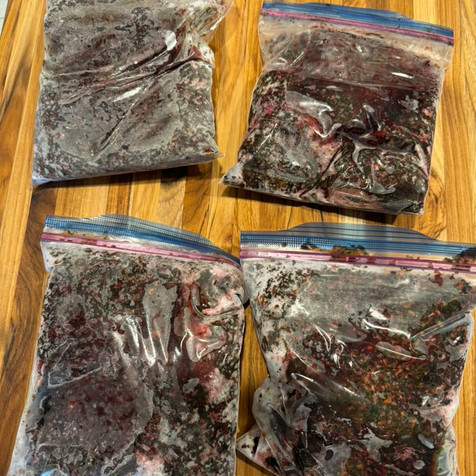How to Create the Ultimate Veggie Mash Up 101: Tips and Tricks
- Carole
- Jan 22
- 4 min read

What is the veggie mash up?
I first heard about this after I watched the Netflix documentary, “Hack Your Gut.” last year. I highly recommend this light hearted and informative documentary that demystifies the role gut health plays in our overall well-being. There are 3 ways to support our gut microbiome: probiotics, prebiotics, and phytochemicals, basically referred to as the “3 P’s."
The hostess, Dr. Guilia Enders, author of Gut, explains the role that fiber plays in feeding the good bacteria in your gut. It’s fascinating that the gut is home to trillions of bacteria, and their preferred food is fiber. Several experts in the video recommended consuming 30 different plants over the course of the week, striving for 30 - 50 grams of fiber per day. Not only is a higher intake of fruits and vegetables associated with lower mortality, but fruits and vegetables contain vitamins, minerals, fiber, and polyphenols. These compounds give plants their vibrant colors, and also provide antioxidant (cancer fighting) and anti-inflammatory benefits. Basically, by “eating the rainbow,” you’re fueling your body with diverse nutrients that support overall health and vitality.
Let’s get real for a moment, shall we?
There are 7 days in a week. 30 divided by 7 = 4.28 different fruits and vegetables per day.
Personally, I feel like I’m a pretty healthy eater, but this feels like a tall order, even for me.
So, I reached out to my NTP tribe on Facebook, and after a brief search, discovered the “Veggie Mashup.”
This was created by Dr. Datis Kharrazian, the founder of Apex Energetics supplements. It’s also known as the “Microbiome Mashup” This is basically medicine for your gut microbiome, your immune system, your brain, and your overall health. Read his article linked here to get a more detailed explanation of the rationale behind it.
LOGISTICS
I went to the Olympia Food Co-Op as well as my local Fred Meyers and bought these organic vegetables. It’s important to use only organic vegetables as pesticides and herbicides negatively affect the gut microbiome. I spent $33 at each store and came home with 35 veggies. I didn’t include any fruit or garlic in this rendition I sorted the vegetables into 3 piles, specifically choosing a nice blend of greens, flavors, root veggies, brassicas, nightshades, squash and mushrooms. Fortunately, I like and tolerate all of these vegetables. Also, I specifically chose vegetables that I don’t normally buy - for example, sunchokes, radicchio, rutabaga, and parsnips. Here’s the breakdown -
GREENS
Collard Greens
Dandelion Greens
Red Kale
Mustard Greens
Spinach
Swiss Chard
Watercress
FLAVORS
Leeks
Red onion
Green onion
Shallot
Ginger
Parsley
Radicchio
Fennel
ROOT VEGGIES
Celeriac
Red beet
Golden beet
Parsnip
Carrot
Rutabaga
Sunchokes
Turnip
Watermelon radish
BRASSICAS
Red cabbage
Bok Choy
Broccoli
NIGHTSHADES
Orange pepper
Yellow pepper
SQUASHES
Yellow squash
Zucchini
Butternut squash
MUSHROOMS
Shiitake mushrooms
Portobello mushrooms
White mushrooms

BATCH #1 total = 11
Carrots
Ginger
Leek
Mustard greens
Red cabbage
Yellow pepper
Rutabaga
Swiss chard
White mushrooms
Green Zucchini
Red onion

BATCH #2 total = 12
Bok Choy
Celeriac
Collard Greens
Fennel
Golden beet
Red Kale
Parsley
Portobello mushroom
Spinach
Turnip
Yellow squash
Shallot

BATCH #3 - total = 12
Broccoli
Butternut Squash
Dandelion Greens
Green onion
Orange pepper
Radicchio
Red beet
Parsnip
Shiitake mushrooms
Sunchokes
Watercress
Watermelon radish
STEP BY STEP
I washed all of my produce in vinegar water.
I peeled the tough veggies - squash, parsnip and beets.
I discarded stems from the peppers, and the outer skin of the onion, but used carrot tops, beet greens, etc.
I used my Cuisinart food processor to chop the vegetables into small bits, and dumped it all into my big mixing bowl.
After I processed all of the veggies and added them to quart freezer bags, I removed as much air as I could, and packed them flat in my freezer.
This made a total of 4 quart bags of each batch.
How to eat your veggie mashup:
1. Break off or cut a piece that is approximately 1 - 2 Tbsp.
2. Defrost and add to smoothie, soup, eggs, etc. Some people add it to a glass of water and chug it.
3. Rotate your batches so you eat from all three bags each week. For example:
Monday - 1 Tbsp from Batch #1
Tuesday - 1 Tbsp from Batch #2
Wednesday - 1 Tbsp from Batch #3
Thursday - Saturday- repeat rotation.
Sunday - Pick your favorite
In this example, I’m getting 35 veggies in my week twice over, in addition to the 30+ grams of fiber that I strive to get in over the course of my 3 daily meals.
Changes I will make the next time I make it
1. I will add polyphenol-rich fruits such as concord grapes, red grapefruit, cranberries, and pomegranate seeds to encourage the growth of Akkermansia Muciniphila. Cranberries and grapes in particular contain a class of polyphenol called proanthocyanidins, which stimulates the production of mucin, which is what A. Muciniphila loves to eat. While you cannot, at this point, supplement with Akkermansia Muciniphila directly, incorporating a supplement that includes bifidobacterium species can support the proliferation of A. Muciniphila indirectly.
2. I will freeze by the spoonful on a cookie sheet and/or in ice cube trays. Breaking off chunks isn’t as easy as it sounds.
Additional Considerations
1. Individuals with certain digestive disorders may find that high-fiber diets exacerbate their symptoms. These can include inflammatory bowel disease (IBD), irritable bowel syndrome (IBS), or small intestinal bacterial overgrowth (SIBO).
2. People who have had gastrointestinal surgeries may need to limit fiber intake.
3. For some people with autoimmune or kidney conditions, lectins, nightshades, and oxalates may be problematic, so specific vegetables shouldn’t be included in the mashup.
Everyone is different, so always listen to your body, and keep an open mind. Feel free to choose your own mix of vegetables/fruits. Start smaller if 30 sounds like too many, for example, 10. Don't let this "recipe" overwhelm you. Likewise, if you don't eat a tablespoon every day, your gut won't hate you. The whole point of this recipe is to "game the system" and "hack your health" so your gut microbiome is healthy, happy and diverse. Happy eating! I'd love to hear your comments/experience with this if you try it.








